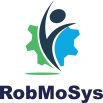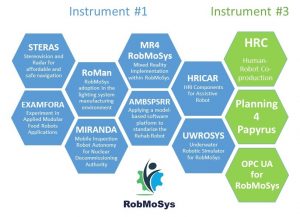The following projects will receive 6 months of funding from the European Union’s Horizon 2020 Research and Innovation Programme under the RobMoSys project:
For Instrument #1 Fast adoption of the RobMoSys approach in industry we have selected:
Underwater Robotic Simulator for RobMoSys (UWROSYS)
Unmanned Underwater vehicle (UUV) operations are expensive endeavors with high risk profiles and are being used for increasingly more complex tasks. Many of the tasks performed with UUVs are done on a regular basis, such as routine inspection, maintenance, and repair (IMR). Increasing the level of autonomy in these operations can both reduce time and cost, while also providing additional reliability that reduce the risks for accidents. Testing in underwater environments is challenging, and the availability of a good simulation platform is necessary to achieve robust performance. Subsea IMR tasks are fundamentally important for subsea infrastructure and require complex autonomy to replace human operators. The current simulation platform in the RobMoSys conformant SmartMDSM toolchain is limited to above water applications, and UWROSYS attempts to alleviate this by building on the Gazebo/TIAGo/SmartSoft Scenario and the Intralogistics Industry 4.0 Robot Fleet Pilot. UWROSYS will bring a high fidelity underwater robotic simulator with advanced sensors into the framework of RobMoSys – opening the underwater domain to RobMoSys users.
Mobile Inspection Robot Autonomy for Nuclear Decommissioning Authority (MIRANDA)
The objective of the MIRANDA project is to use RobMoSys with existing GMV hardware and software to produce a system capable of running a typical field trial in the context of a nuclear site. This demonstration requested by the Nuclear Decommissioning Authority (NDA) will allow GMV to bring together WatchChainR and ARISE developments, access a new user for the technology and create RobMoSys compliance. The GMV Brain autonomy software, and the BEAST robotic platform, currently undergoing development and field trials, will be integrated using the RobMoSys interface design tools. Each will be represented by separate RobMoSys components. In this way, the GMV software, both autonomy and platform-specific components, can be used to evaluate the RobMoSys approach and structures. GMV will use existing developments with the aim of creating a long-term product with RobMoSys compliance.
Mixed Reality Implementation within RobMoSys (MR4RobMoSys)
The interaction between humans and robots can be facilitated with an appropriate visualization and user interface. The emerging technology for this is Augmented and Virtual Reality, which shows a hugh potential especially in the context of robotic applications. This project aims for using an existing Bridge between ROS industrial and the game engine Unity developed in a ROS_In FTP in order to implement an AR/VR visualization in the context of University of Ulm’s pilot “Intralogistics Industry 4.0 Robot Fleet Pilot”. Awesome Technology is a small German company funded in 2017 and located in Würzburg. We see four different application scenarios for AR/VR technology within the context of a smart logistics system: i) Installation ii) Interaction with workers at the factory floor iii) maintenance and troubleshooting and iv) supervisor. We want to develop our existing framework further with the help of the SmartMDSD approach and Papyrus for Robotics.
Applying a model-based software platform to standarize the Rehab Robot (AMBSPSRR)
Canonical Robots has developed a medical system capable of highly articulated movements to provide precise therapeutic treatment by applying compressed air, the “Rehab Robot”. This innovative efficient approach has proven to produce the same effect on the patient’s back as manual therapies, reducing treatment time compared to current solutions. In this application, we propose a project that will mainly consist of adapting some of the functionalities implemented in the “Rehab Robot”, related to human-robot interaction to develop a RobMoSys-conformant pilot based on existing assets (software and tools from the RobMoSys ecosystem).
HRI Components for Assistive Robot (HRICAR)
In this project, we will develop a set of RobMoSys models and components for the area of human-robot interaction, and we will adapt some components from FIONA platform to make it RobMoSys compliant. Once the developed components are available we will integrate the developed components into the Assistive Mobile Manipulation Pilot and specifically we will focus on the use of case of create assistive applications for TIAGo.
RobMoSys adoption in the lighting system manufacturing environment (RoMan)
One of the key industries implementing advanced robotics is manufacturing. For this reason RoMan would like to take the chance to build an industrial application with the Summit-XL Steel robot in a company focused on the manufacturing of lighting systems. The Summit-XL Steel robot is a mobile platform manufactured by ROBOTNIK that has omnidirectional kinematics and can carry up a load up to 250 kg. This makes it ideal for industrial purposes. ROBOTNIK is the manufacturer of several mobile platforms and it is also in charge of the development and integration of many real applications in companies. This project would proof the re-usability of the RobMoSys methodology in new robots and the benefits of its structure to build industrial applications.
An Experiment in Applied Modular FOod Robots Applications (EXAMFORA) – exclusive cut-off*
The EXAMFORA project is an investigation into the use of the RobMoSys method within a hard real-time system (The GRAIL robot). The application is for a vision based system that increases the overall efficiency of an assembly system involving human-robot interaction by choosing paths that are least likely to result in collisions. If successful the RobMoSys approach will be applied to other parts of the GRAIL system during an upcoming port to a new industrial robot platform. Although no time savings are expected in this first port, considerable time savings would be expected in subsequent ports.
Stereovision and radar for affordable and safe navigation (STERAS) – exclusive cut-off*
Avular is developing a low-cost navigation system, that is capable of simultaneous localization and mapping (SLAM). This allows mobile robots and drones to navigate autonomously and safely through a dynamic territory in the presence of dynamic objects such as other robots, humans or cars. The navigation system is based on the fusion of a radar- and stereovision-sensor through artificial intelligence (AI). Avular aims to prove software safety by following the RobMoSys methodology to develop the software. The lower price of this navigation system opens up new markets for the exploitation of mobile robots in a range of verticals.
(*exclusive cut-off: The RobMoSys consortium decided to ad an exclusive cut-off date only for rejected proposals of Instrument #1 “Fast Adoption” and #3 “Innovation Expert Intake”. They were contacted individually and encouraged to send a revised version of their proposal, taking into consideration the feedback they had received. They had 1 month to hand in their proposal.)
————————————————————————————————————————-
For Instrument #3 Innovation Expert Intake we have selected:
Human-Robot Coproduction (HRC)
There is more to a successful system than to merely “work” as specified. In addition to this, the successful integration into the socio-technical context is critical for the overall success of a system. As many pilots of the RobMoSys project directly cover human-in-the-loop scenarios, the context of questions regarding human-robot interaction and especially evaluation for the pilot cases and for the corresponding projects from Instrument #1 and #2 need to be ananlyzed. HRC will discuss with the consortium, how the RobMoSys’ goal of a composable system can be integrated with a model of ensured usability by the human operator, and if possible, contribute to this.
OPC UA for RobMosys
The objective of the project is to extend OPC UA capabilities of RobMosys project. Indeed, OPC UA has been identified a key vector for RobMosys dissemination. Our OPC UA and cybersecurity expert will help RobMosys members on the subject.
Guidelines for improving Papyrus for Robotics with PDDL Planning (Planning4Papyrus)
Planning 4Papyrus aims to advise the designers and developers of the Commissariat à l’Énergie Atomique(CEA) to include a PDDL-based planner in the Papyrus for Robotics tool. This planner will be applied in the Human-Robot Collaboration for Assembly pilot, which CEA is carrying out. The objectives are i) Discuss the possibilities and advantages of planning in the development of robotic behaviors, ii) To extend Papyrus for Robotics with a PDDL-based Planner, iii) Explore the possibility of combining a PDDL-based Planner with Behavior Trees, and iv) Analyze how to generate problems and domains in PDDL dynamically to from models that comply with RobMoSys.

